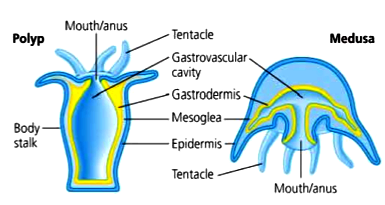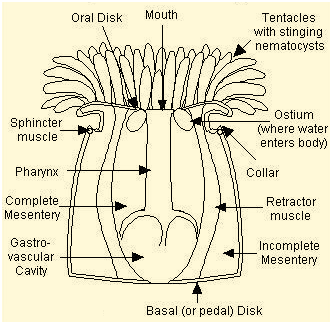Phylum Cnideria (Coelentrata)
Table of Content |
Introduction to Phylum Cnideria

 - “Tissue grade” eumetazoans with a radial symmetry.
- “Tissue grade” eumetazoans with a radial symmetry.
- The term “Coelenterata” signifies the presence of a single internal cavity called coelenteron, or gastrovascular cavity, combining functions of both digestive and body cavities.
- The term “Cnidaria” indicates the presence of stinging cells (Gr., knide = nittle or stinging cells). About 9,000 species known.
Brief History
-
Peyssonel (1723) and Trembley (1744) proved these to be animals.
-
Hence, Linnaeus (1758), Cuvier (1796) and Lamarck (1801) included these under ‘Zoophyta’, together with sponges.
-
Leuckart (1847) included sponges and cnidarians under his phylum Coelenterata.
-
Finally, Hatschek (1888) divided “Coelenterata” into three phyla–Spongiaria (= Porifera), Cnidaria and Ctenophora.
Salient Features
Phylum coelenterata has the following salient features:
(1) Coelenterates are multicellular organisms
(2) They have tissue-grade of organization
(3) The body is radially symmetrical. Radial symmetry is the symmetry of a wheel
(4) All the members of this phylum are aquatic
(5) They are solitary or colonial
(6) Two types of individuals occur in the life cycle. They are polyps and medusa
(7) The body wall is diploblastic. It is made up of two layers of cells, namely the ectoderm and the endoderm with a non–cellular layer called mesogloea in between.
(8) Nematocysts or stinging cells are present
(9) Coelom is absent. Hence coelenterates are acoelomate animals
(10) A gastrovascular cavity or coelenteron is present. It can be compared to the gut of higher animals.
(11) Mouth is present; but anus is absent
(12) Digestion is extracellular as well as intracellular
(13) Respiratory, excretory and circulatory system are absent
(14) Nervous system is diffuse-type, formed or nerve-nets.
(15) Reproduction is by asexual and sexual methods
(16) Development is indirect as there are one or two larval forms
(17) Life history has alternation of generations or metagenesis.
Classification of Coelenterata
Phylum coelenterata is divided into three classes:
Class 1. Hydrozoa
(1) Hydrozoa are solitary and fresh water or mostly colonial and marine, sessile and free-swimming forms.
(2) They exhibit tetramerous or polymerous radial symmetry
(3) Body wall consists of an outer ectoderm and an inner endoderm separated by a non–cellular gelatinous mesogloea.
(4) Gastrovascular cavity without stomodaeum, septa or nematocysts bearing gastric filament
(5) Skeleton or horny structure is horny perisarc in some forms, while coenosarc secretes a skeleton of calcium carbonate forming massive stony structure or coral in other forms.
(6) They exhibit polymorphism. There are two main types of zoods, the polyp and medusa. Medusa is provided with true muscular velum.
(7) Many hydrozoa exhibit alternation of generation
(8) Reproductive products of sex cells are usually ectodermal in origin and discharged externally.
(9) Cleavage is holoblastic, embryo ciliated planula.
(10) Examples : Hydra, Tubularia, Bougainvillea, Hydractinia, Eudendrium, Pennaria, Obelia, Sertularia, Plumularia Companularia, Millepora, Stylaster, Geryonia, Physalia, Porpita, Velella, Pericolpa, Periphylla, Aurelia, Cynaea, Rhizostoma or Pilema Cassiopeia, etc.
|
Class 2. Scyphozoa
(1) Scyphhozoa include large jellyfishes or true medusae.
(2) They are exclusively marine.
(3) Medusae are large, bell or umbrella-shaped and without true velum. They are free swimming or attached by an aboral stalk. 
(4) Marginal sense organs are tentaculocysts
(5) Polypoid generation is absent or represented by small polyp, the scyphistoma which gives rise to medusae by strobilization or transverse fission.
(6) Gastrovascular system is without stomodaeum, with gastric filaments and it may or may not be divided into four inter-radial pockets by septa.
(7) Mesogloea is usually cellular
(8) Gonads are endodermal and the sex cells are discharged into the stomach.
(9) Class scyphozoa is divided into five orders, namely Stauromedusae, Cubomedusae, Coronatae, Semaeostomeae and Rhizostomeae
(10) Examples : Lucernaria, Haliclytus
Class 3. Anthozoa
 (1) These are solitary or colonial exclusively marine forms
(1) These are solitary or colonial exclusively marine forms
(2) They are exclusively polypoid. Medusoid stage is altogether absent
(3) Body is cylindrical with hexamerous, octomerous or polymerous biradial or radiobilateral symmetry
(4) The oral end of the body is expanded radially into an oral disc bearing hollow tentacles surrounding the mouth in the centre.
(5) The stomodaeum is often provided with one or more ciliated grooves, the siphonoglyphs.
(6) Gastrovascular cavity is divided into compartments by complete or incomplete septa or mesenteries.
(7) Mesenteries bear nematocysts at their free edges
(8) Mesogloea contains fibrous connective tissue and amoeboid cells.
Subclass 1. Alcyonaria (Octocorallia)
(1) These are colonial marine forms
(2) Polyps are long or short cylinders terminating orally into a flat circular oral disc having the oval or elongated mouth in the centre
(3) Polyps always bear eight pinnate, hollow tentacles
(4) Eight complete mesenteries are present.
(5) Single ventral siphonoglyph is present
(6) Endoskeleton is the product of mesogloeal cells comprised of calcareous spicules either calcareous or horny in nature.
(7) Polyps are dimorphic in some forms.
(8) Examples : Tubipora, Calvularia, Alcyonium, Xenia, Heliopora, Gorgonia, Corallium, etc.,
Subclass 2. Zoantharia (Hexacorallia)
(1) These are solitary or colonial marine forms
(2) Tentacles simple, rarely branched, hollow cone shaped, numerous arranged in the multiple of five and six but never eight
(3) Mesenteries are numerous arranged in the multiple of five or six, may be complete or incomplete
(4) Two siphonoglyphs are commonly present
(5) Endoskeleton when present is calcareous, derived from ectoderm
(6) Polyps are usually monomorphic.
(7) Examples : Actinia, Metridium, Adamsia, Edwardsia, Astraea, Fungia, Zoanthus, Antipathes


Question 1: Which one of the following is a cnidarian
(a) Sea urchin
(b) Sea cucumber
(c) Sea pen
(d) Sea horse
Question 2: Which of the following is a polymorphic coelenterate
(a) Physalia
(b) Fungia
(c) Hydra
(d) All of these
Question 3: Most appropriate term to designate the life cycle of Obelia is
(a) Neoteny
(b) Metagenesis
(c) Metamorphosis
(d) None of these
Question 4: Which of the following does not belong to phylum Coelenterata
(a) Sea pen
(b) Sea feather
(c) Sea cucumber
(d) Sea fan
Question 5: Sea anemone belongs to class
(a) Hydrozoa
(b) Anthozoa
(c) Scyphozoa
(d) None of these
Question 6: A coelenterate commonly known as 'fresh water polyp' is
(a) Aurelia
(b) Hydra
(c) Obelia


| Q.1 | Q.2 | Q.3 | Q.4 | Q.5 | Q.6 |
| c | a | b | c | b | b |
Related Resources
-
Click here to refer the Useful Books of Biology for NEET (AIPMT)
-
Click here for study material on Animal Kingdom
To read more, Buy study materials of Animal Kingdom comprising study notes, revision notes, video lectures, previous year solved questions etc. Also browse for more study materials on Biology here.
View courses by askIITians


Design classes One-on-One in your own way with Top IITians/Medical Professionals
Click Here Know More

Complete Self Study Package designed by Industry Leading Experts
Click Here Know More

Live 1-1 coding classes to unleash the Creator in your Child
Click Here Know More


